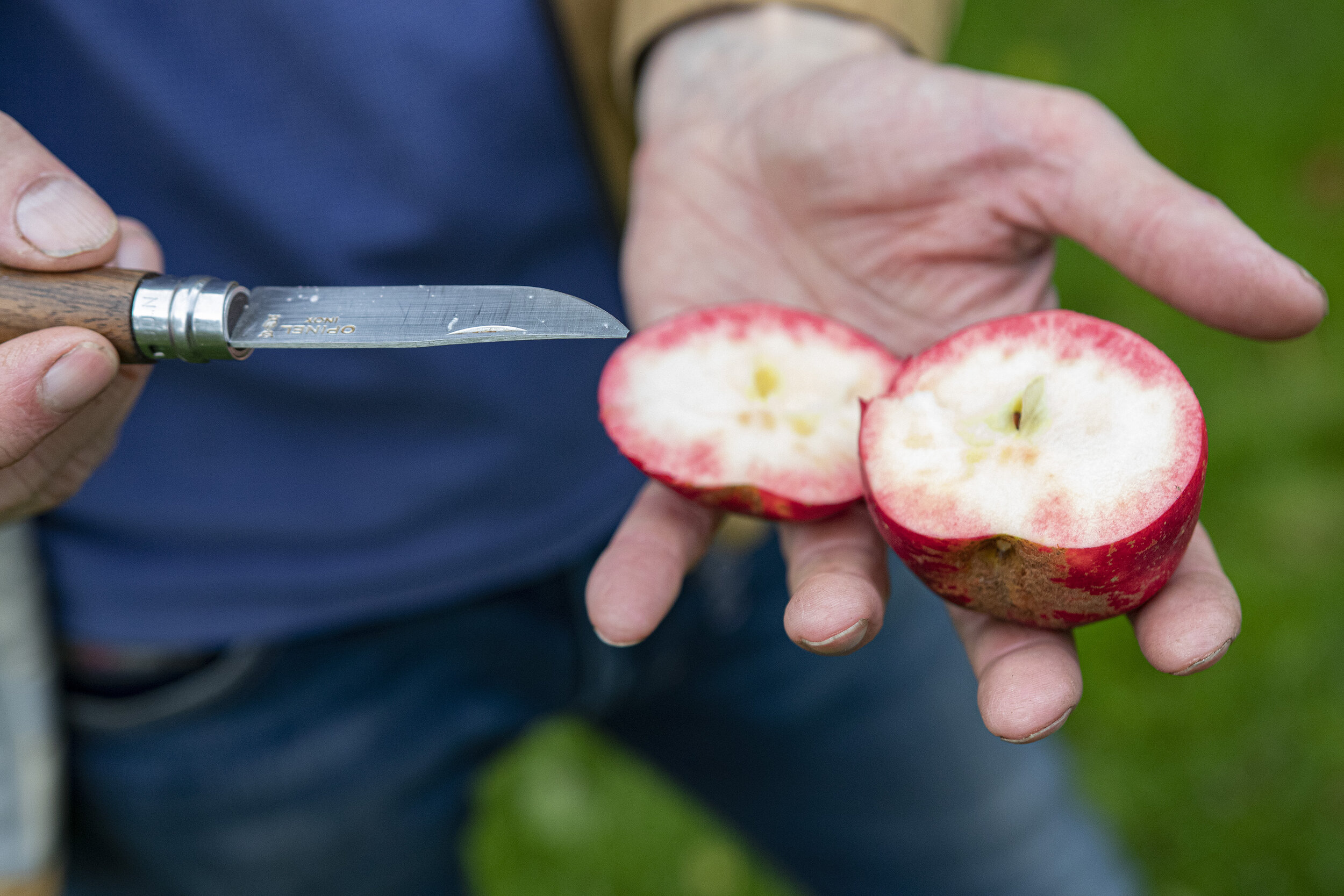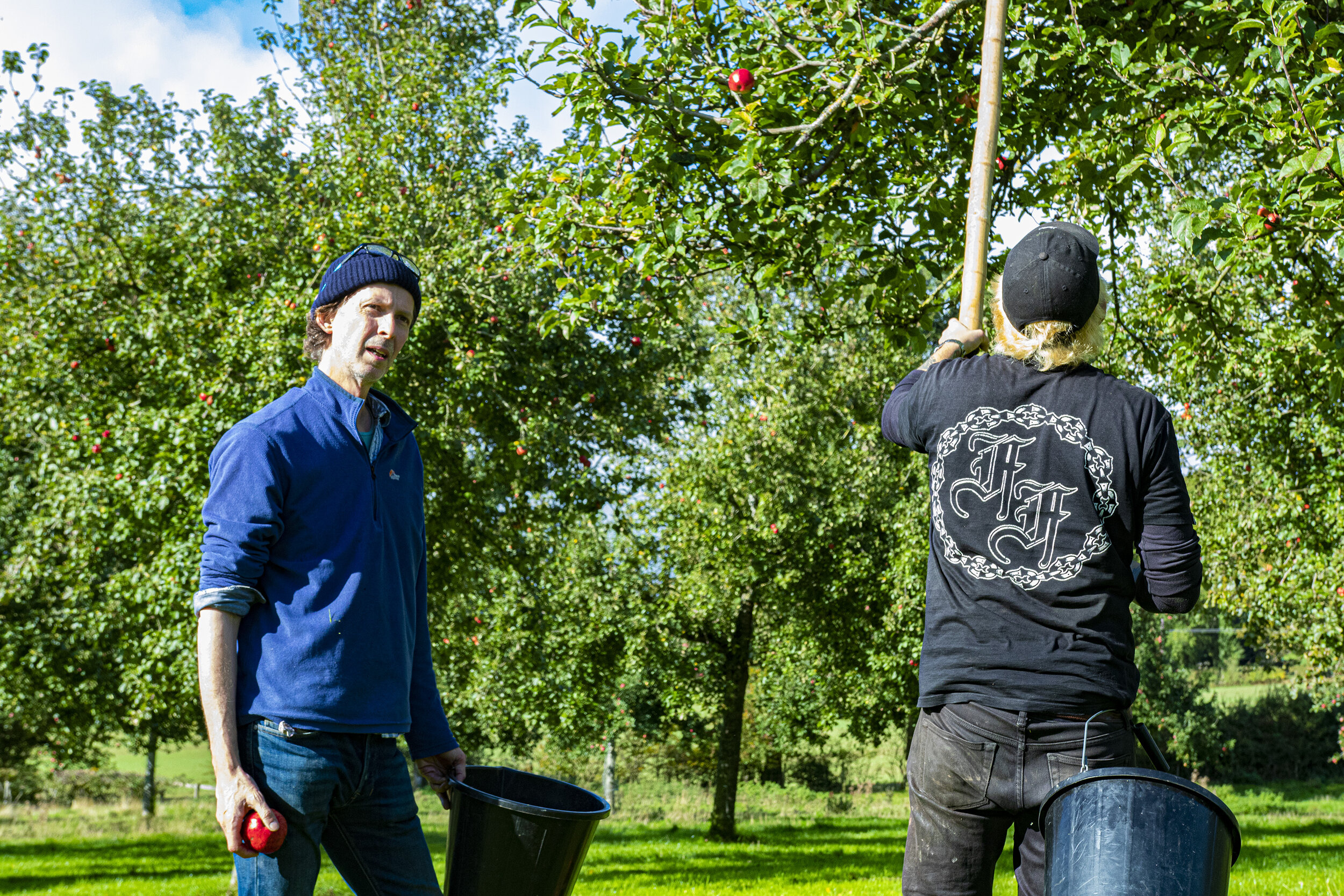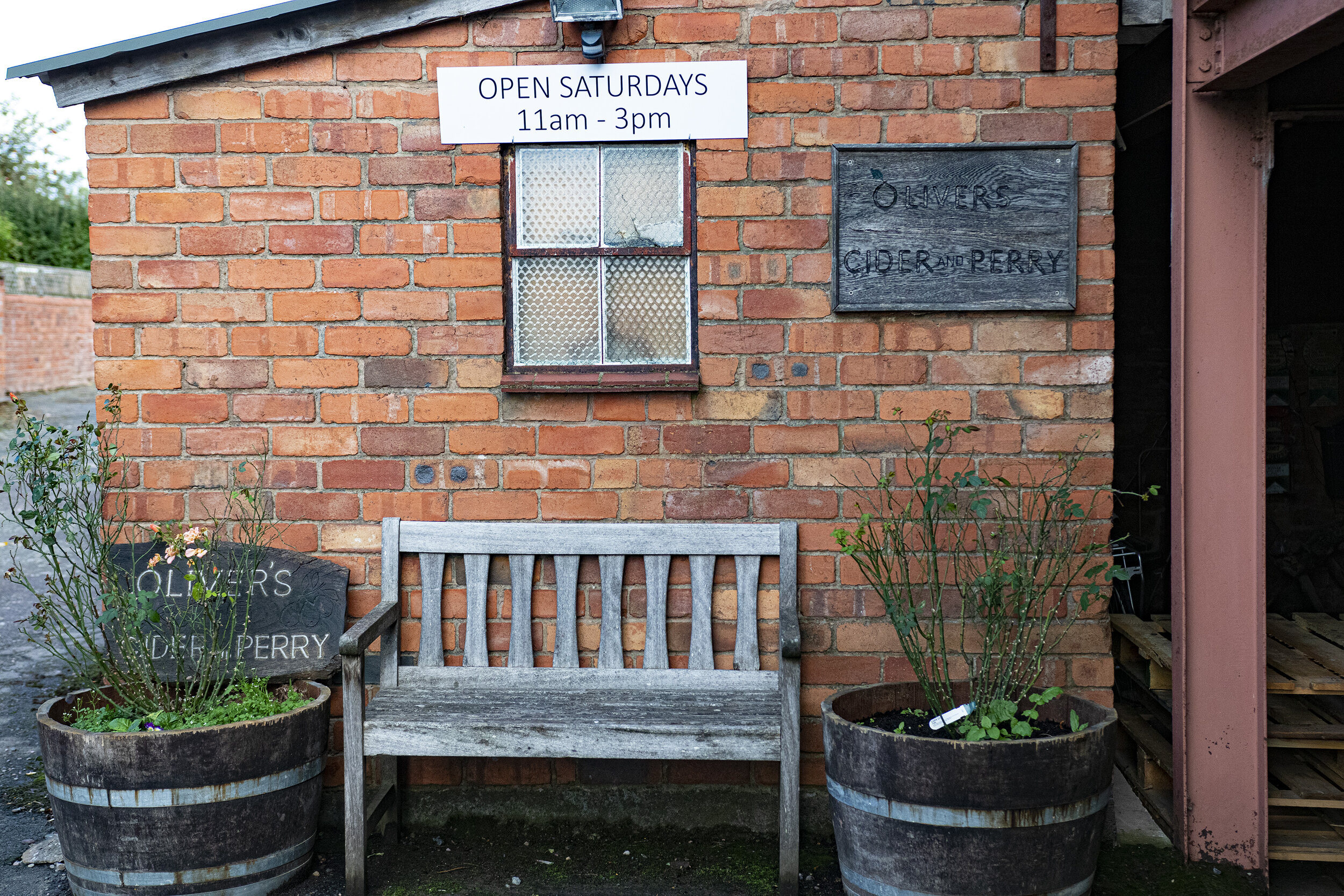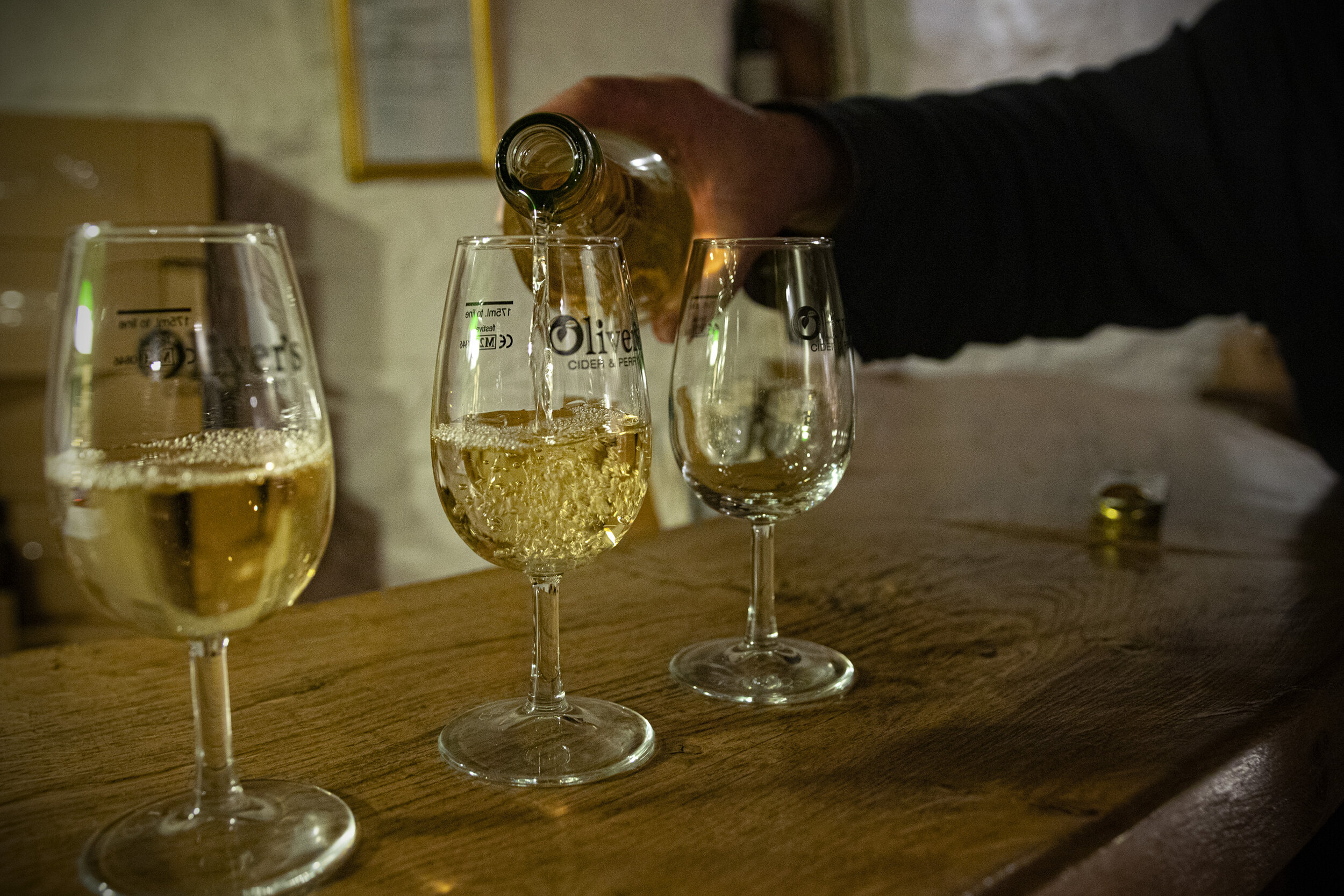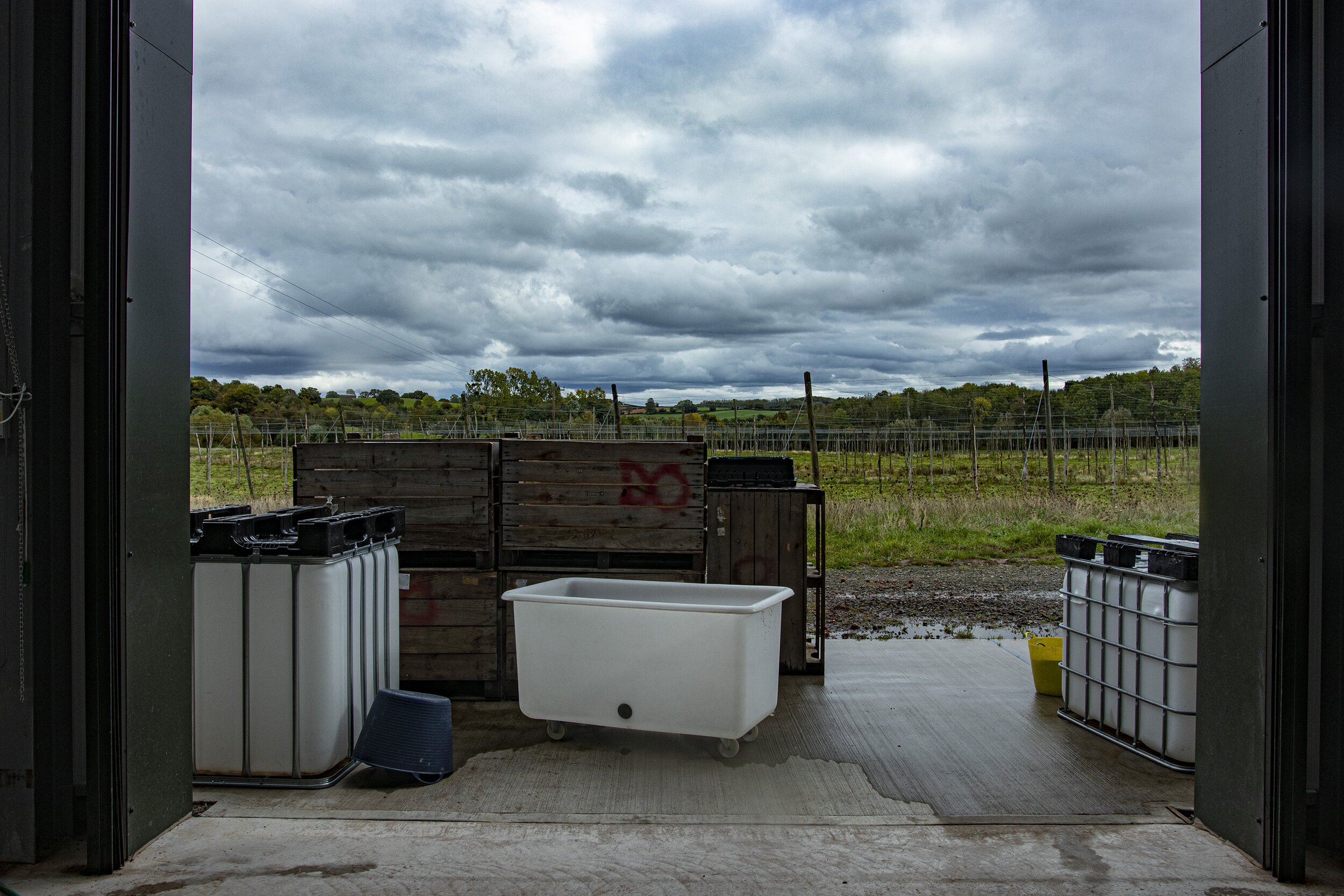I arrive in a state of disorientation.
My day began with the potent mix of a 5 a.m. alarm, a sunrise viewing, and three coffees. As a result, I’m struggling to reconcile where I am with where I was. Four hours ago I left central London, the city in a state of lockdown and still dark gray in the dawn. Now, I’m outside a cottage in leafy, rural Herefordshire.
Everything is silent except the birds, still singing their morning chorus. I knock on the door, and am promptly greeted by a thump and the unmistakable bark of a dog who hasn’t been outside yet. James Forbes, co-founder of Little Pomona Cider & Perry, grabs its collar and waves a greeting through the window as he fumbles for the key. The door opens a crack and the spaniel is on me, all clumsy paws and hot breath.
James apologizes for Joey’s enthusiasm and offers me coffee. I opt for tea because the edges of my vision are already blurred, and because I have a suspicion I’ll have my hands full of dog for a while yet. I’m early and Susanna, co-founder of Little Pomona and James’ wife, is still in her pajamas. After a hurried hello, she runs upstairs to get ready.
The day’s schedule is full but fluid, James tells me. We’ll be picking in the couple’s own orchard in the morning if the weather holds, then will head to master cider maker Tom Oliver’s farm nearby to grab some ciders. The following stop will be Little Pomona’s production site, where we’ll help clean and mill a ton of quince, before returning home for dinner and a Zoom catch-up with Albert Johnson, son of the founder of the Ross-On-Wye Cider & Perry Company, Mike Johnson.
Maybe I should have had that fourth coffee.
By the time we head out to the orchard behind the family home, the day has warmed up nicely, though there are dark clouds on the horizon.
James and the couple’s cider-making assistant, Blair Côté, get to work immediately. Côté grabs the panking pole—a long pole with a hook on the end of it—and loops it around a branch, shaking it in a way that reminds me of a bartender making a cocktail. A shower of apples plummets, hitting the damp grass with satisfying thuds. Leaving the panking pole hanging, he and James start collecting the fruit in buckets tied to their waists, throwing away the odd apple that doesn’t meet their standards. Eager to assist, I grab a few fruits, but quickly realize I have no idea which are keepers and which need to go. Seeing my confusion, Susanna offers to give me a tour of the orchard.
“It has the perfect aspect,” she says. “The sun shines right across it while the wind whips straight up it, self-pruning the leaves and helping keep off infections. We were so lucky to have found it.”
“There are two kinds of ripeness—sweet ripeness, which is the conversion to sugar, and aromatic ripeness. That’s what we look for when we’re picking.”
Luck might have been involved, but it still took years to find the site. Susanna and I have known each other for a while, back when we both worked as drinks journalists in London. At the time, she had a reputation as a dogged, dedicated writer and editor, and was also a board member of the British Guild of Beer Writers. I’d had no idea of her passion for cider until she told me she’d moved to Hereford to start a cidery.
Initially, Little Pomona was, true to name, a shed-sized endeavor. The Forbeses used their own apples, plus small quantities of fruit from local orchards. Recently, the couple raised enough funding to take on a huge site on the same farm as hop grower Brook House, which is itself one of the new investors.
The next few years are going to be all about making that site commercially viable. It sounds ambitious, particularly given everything that’s going on in the world, but Susanna talks about it as lightly and excitedly as she does about her apples, which she happens to be force-feeding me.
As if my head weren’t swimming enough, I’ve learned more about apples in a few minutes with Susanna than I have in the 33 years that preceded them. She tells me about all kinds of varieties—both those now lost and those still found in the U.K.—and how they can be loosely divided into cider and dessert apples, then further into sweet, sharp, bittersweet, and bittersharp. The key to making great cider starts with a producer’s understanding of those flavors—not only in terms of which apple varieties to use, but also when to pick them.
“There are two kinds of ripeness—sweet ripeness, which is the conversion to sugar, and aromatic ripeness, says Susanna. “That’s what we look for when we’re picking.”
The point at which the apples ripen seems to vary widely, not just from variety to variety but from orchard to orchard, tree to tree, apple to apple, and even side to side of the apple. Some look perfect on one side, but are still green and starchy on the other, and yet we try them all. A great producer doesn’t just need a well-honed palate; they also need patience, confidence in their instincts, and an insatiable appetite.
Eventually, we reach the far end of the orchard, which is shady and sheltered—a relief because the heavens are about to open. Susanna says they won’t be picking from these trees for a good few weeks because they always ripen last. Her orchard is only a few decades old: pretty young in the grand scheme of things, but by no means unusual. It was planted by a previous owner, who did so in a bid to get a tax relief offered by the government to encourage the formation of orchards. Thankfully, he had the sense to put a particular variety in the shade.
“This is foxwhelp,” she says with a smile. “A lot of cider drinkers don’t like it because it’s got such high acidity, but we love it.”
Foxwhelp is a small, pink apple that reminds me of a flat peach. She cuts it open to reveal that the color of the skin has bled into the watery flesh. I bite into a wedge, and am immediately reminded of a young Gueuze—there’s sherbet, fragrant apple skin, and tart juice. It’s complex and moreish, unlike any apple I have ever tasted before. I struggle to imagine people dismissing this for its acidity. Sure it’s assertive, but in wild-fermented drinks isn’t that to be expected, or even celebrated? Apparently not.
“I was at a blind judging once,” says James. “The lead judge opened a bottle, took one sniff, and put it away rather than pour it out for us. I asked why and he said, ‘It’s Foxwhelp.’”
After a few hours, my back is sore both from my amateur use of the panking pole and a life spent at a desk rather than crouched down picking up apples. Mercifully, Susanna says it’s time to drive over to Oliver’s Cider.
Tom Oliver has become the focal point of the U.K.’s contemporary cider revolution, a title he wears with ease, despite never asking for it. The industry is lucky to have such a talented and easygoing champion, as well as one who’s very happy to push boundaries. He’s one of the few cider makers—alongside Little Pomona—brave enough to make 100% foxwhelp cider, for instance, and is also known for his heavy use of barrels as a flavor component in his ferments.
Turning off the road at his farm, I am strongly reminded of my past trip to Hill Farmstead Brewery in rural Vermont—there’s the understated wooden sign, the wood-clad outbuildings, the sense of anticipation that builds as you drive down the long track. Of course, everything that excites a visitor is old hat to the person who works there. While I take in the sights, Oliver is busy telling me about his new concrete floor.
“It’s amazing to me that I can now walk from the shop to the cider press without getting covered in mud,” he enthuses.
We make that walk, and enter a forest of steel and plastic IBCs, either full of this season’s juices or waiting to be filled from the whirring press just behind them. Two men stand about, watching the machine work and occasionally tipping more fruit into the wash. The big, bearded guy is Jarek, Oliver’s right-hand man, while the other is Ben—a seasonal worker there on time off from his day job at London’s Five Points Brewing Company.
Oliver leads Susanna and me around to where the fruit goes in and shows us the pears they’re processing today. I never quite establish if they come from Oliver’s own farm, but he’s very excited about how perfectly ripe they are. He grabs one and cuts it in half.
“It’s not pretty, but that’s what we’re looking for in these pears,” he says, showing me the inside.
To me it looks rotten or bruised, its dark and waterlogged flesh entirely unappealing. Tasting it is a different experience. The tannins dry out my tongue, but a honeyed, floral sweetness washes over it at the same time. It’s intoxicating, and Susanna is clearly keen to try a few of the other fruits lined up and waiting to be milled, so Oliver and I leave her to tour the barrel room.
Oliver takes me to the neighboring barn, through a storage area piled high with his bottles and those of other producers, and into a grid of rooms that feels strangely familiar.
“Our barrel rooms used to be hop kilns,” he says. “On the boards above us is where the hops would go, and we’re where the heat source would be.”
It turns out that Oliver’s family farm was once used for hops. That plan was only abandoned a few decades ago, as the crop’s profitability plummeted thanks to competition from abroad and the slow decline of the U.K.’s traditional brewers. British hops are starting to see a revival again, but the Oliver family’s loyalties have turned, and the hop kilns make a fitting home for the barrels, providing several unique atmospheres in which Oliver can tease out different flavors from the wood. One kiln is damp and warm, one colder and drier, while the corridors around them, which are also lined with barrels, get a fresh breeze through the slats and must expand and contract wildly during the season. The quiet beauty of the set-up is quite affecting—it feels like stepping back in time to a frontier moonshine business.
Oliver pulls me from my reverie by suggesting we go find something to drink. We head through to the shop, where he asks me what I want to try. By now I feel wildly out of my depth, so I say he should choose, and he pulls out a 2017 Blakeney Red Perry—made with the pear variety going through the mill at this very moment. The sweetness is gone, but the floral honey note remains, joined by aromas of rhubarb and apricot as well as a soft, oaky barrel character that emphasizes the fruit tannins. It’s complex, but I can’t help but finish the glass in just a few sips.
Part of that is down to the fact that Oliver is doing all the talking. I’ve asked him about the impact that COVID-19 has had on his business, as well as the coming changes resulting from Brexit. Both scenarios have clearly worried him, but thankfully he has all the hands he needs for the present harvest. This year is a fallow one, with many U.K. varieties of apple taking a break after a few seasons of high yields. Other businesses, meanwhile, have been hit by severe shortages of workers, including both hop and grape farms.
At the moment, Oliver explains, business is busy. His ciders are still selling well, thanks to a recent switch to ecommerce by his wholesalers and the continued growth of export. But he worries that this is because everyone is stocking up, whether it’s the home drinker hitting the free-shipping limit or cautious mainland European importers worried about the additional fees and red tape that are likely to come with Brexit.
“Brexit means people are buying early—we don’t know what will happen after December. I’m still 20% down on where I expected to be this year, but to be honest I’ll take that. ”
“Brexit means people are buying early—we don’t know what will happen after December,” he says. “I’m still 20% down on where I expected to be this year, but to be honest I’ll take that.”
In any other year, a 20% drop in sales would be catastrophic for a business like Oliver’s. In 2020 it is deemed a success. A few glasses in and we’ve become philosophical, agreeing this could just be the storm before the calm.
It’s a wrench leaving Oliver’s, but he has a lot of fruit to process, and so does Little Pomona. It’s about a 20-minute drive back to their production site, nestled at the bottom of the hill on Brook House Farm.
The warehouse is huge, and would be a serious statement of intent for a brewery, so I’m surprised to learn they expect the capacity to be only around 2,500 hectoliters (roughly 2,130 U.S. barrels). Most of Little Pomona’s cider sits in barrel or tank for well over a year, compared to a matter of weeks for most beers. That means a lot of forward planning and space for not a lot of liquid.
James and Côté are already there, washing and milling a few pallets of quince. Having never eaten quince in its raw state, and getting into the swing of trying absolutely everything that can be juiced, I take a slice. The first thing I notice is the texture—closer to potato than apple, with a tough and starchy feel. But on the tongue it’s as acidic as a lemon, the sourness biting at every corner of my mouth. Juice is invariably sweeter than the flesh it comes from, though, and the first pressings couldn’t be more different. The liquid is richly sweet and tangy, with deep orange notes and a pithy tingle, as well as a soft and cleansing tannin reminiscent of pomegranate juice. None of us can quite believe how delicious it is, and we pass around a jug for a good few minutes, just drinking it in.
There is, however, a lot more juicing to be done. The fruit is loaded into the cylinder in the middle of the room, where a giant balloon inflates to crush the milled flesh and squeeze out the liquid. The cylinder then rotates to drop all the juice into a bucket underneath. It’s a slow process, hampered by the comically small pump that transfers the juice to the IBC where it will ferment.
When I press James on what he’ll do with the pressing, he shrugs—he won’t decide exactly where this ferment is best used for at least a year, and it probably won’t see the light of day for another year after that.
“Right now we’re planning for 2022 and beyond in terms of what we’re collecting and pressing,” says James. “Really, cider making is closer to wine making, and anything we add quince to will be taxed that way, too.”
His simple explanation encapsulates the battle that cider is fighting right now. In the U.K., cider does not have a good reputation. To most, it’s drunk by the pint by people who never got past the bitterness of beer in their teens. It’s been that way for a long time, so when natural cider—made with full juice and wild yeasts—started its renaissance, it found the laws and ideas around the category outdated. Cider is brutally taxed, especially when made with fruits other than apples and pears, keeping it off the bar and in the fridge because it costs too much. Thankfully, restaurants and home drinkers are keeping the crop of independent cider makers growing—at least for now. But I worry for those with the ambition of Little Pomona. How much growth is there in the segment?
“Right now we’re planning for 2022 and beyond in terms of what we’re collecting and pressing. Really, cider making is closer to wine making. ”
As my attention wanders, I walk around all the other tanks in the cidery. There is a real sense of life going on all around you here—it’s not just in conicals lined up against the wall. Their outlets blip away, but so do the barrels, the IBCs, and the small glass demijohns of experiments scattered around the site. Even within the bottles there is secondary fermentation going on, the yeasts devouring that last bit of sugar to create a gentle carbonation. When the press is silent you can hear it all, like soft raindrops.
I wake bright and early and head down to the inviting smell of coffee. This time I gratefully take a strong cup. Today’s plans are much like yesterday’s—driving, picking, milling, pressing—but first we’re off on a scouting mission to the Netherwood Estate, which has several orchards at its highest and most exposed point.
It’s strange to drive onto private property unannounced, but we bounce our way down the tracks and up through the farm without anyone noticing. We’re clearly the first ones through these roads, because they are crowded with hundreds of pheasants scrambling to get out of the way of our tires. In the back, Joey paws at the windows and barks, and James sighs that we won’t be able to let him out of the car for fear of an avian bloodbath.
Where we park, the view extends for miles across the fields, but we’re still not quite at the top. To reach that point, we have to go through the orchards, which look like they’ve seen better days. Several trees have fallen, the apples unlucky enough to be on the ground either eaten away or rotting. There are plenty still upright and laden with fruit, though, so Susanna and James start tracking down those closest to ripeness and tasting them. I’m handed variety after variety to try, and they start to blur in my mind until James comes up to me with a twinkle in his eye, and says, “Try this one.”
“This one” is a Chisel Jersey, a petite and yellowish-red apple that looks innocuous. But the segment I take literally chisels at my tongue, cheeks, and throat. The tannins are so extreme it feels like my entire mouth has turned to ash. It’s clearly a seasoning apple, designed to add texture and finish to a much more balanced and floral blend. On its own, it is inedible.
After a quick lunch of cheese, apple slices, and pork pie that still doesn’t quite wash away the Chisel Jersey, we head out to another local orchard with an empty trailer clanging behind us.
I’m struck by how different the apple harvest is from the hop harvest, which occurred just a month before. In the hop fields, seasonal workers start at first light, zigzagging their way up and down the rows of bines until late afternoon. It’s hard work, involving 10-hour-plus days with few moments to sit down or find shade, and every day is the same. Efficiency is everything, and a good day is a day without interruption, when the maximum amount of hops can be picked and processed.
A good day of the apple harvest could be anything—the discovery of a new orchard, the ripening of a certain variety, the pressing of all the stock waiting. It’s slow and considered, start-and-stop, with no mad rush to the finish. But it’s still physically demanding.
At this new orchard, around 20 minutes from Little Pomona’s site, there are only a few trees—but each one is creaking under the weight of its crop. This is supposed to be a fallow year, but James and Susanna say yields haven’t been far off normal for some varieties. It’s as if the trees know of the cidery’s daring expansion plans.
I’m back on panking duty, slowly getting the knack of it. In other parts of the world they call it knocking, and I see why—while the temptation is to hook a branch and shake the apples loose, for some reason allowing the hook to rattle against the tree is much more effective—it seems to create vibrations that drop apples you can’t even see. Sometimes they fall from the other side of the tree unexpectedly, hitting one of the pickers who thought they were safe. The panking pole also has the unfortunate disposition to act as a slide for apples, which roll down the pole directly at your face. I take a few to the forehead and crown, thanking the stars popping in front of my eyes that we weren’t picking rock-hard quince.
Darkness starts to fall as we load up the trailer, and the decision is taken to deliver the apples to the production site in the morning.
It’s my last night with Little Pomona, and Susanna seems to think I haven’t learned enough yet. As Côté starts prepping pizza and James selects a few bottles of cider to put in the fridge for later, Susanna gets out her favorite books about cider and apples. From my time with the team, it’s become clear that there is a significant conservation element to small-batch cider—not just preserving the culture and flavor of traditional cider, but the actual apple varieties themselves, the orchards they grow in, and the animals that rely on these fruits.
Susanna shows me some beautiful books, lamenting the loss of so many varieties and so much heritage. Mostly what’s left are sketches, designed to help cider makers identify trees in new orchards, but hundreds of the pages are now only good for history lessons.
That said, cider is in an exciting moment. Around dinnertime my replacement volunteer arrives. Rod Graham is from Glasgow, where he works for specialist alcohol retailer The Good Spirits Co. He’s coming down to help out and spend a few days learning more about cider, and after he goes there will be another volunteer to replace him, and another after that, right through to the end of the season, which can stretch as far as December.
The Forbeses put up all their volunteers as well as feed them, but Graham has brought a batch of homemade brownies as a welcome gift, which we pair with Little Pomona’s Do It Puritan! 2018. The name is a joke about how James is labeled a purist when it comes to his blends, but this is a mix of apples, pears, and sour cherries. It’s bright and zingy, nothing like the rich and amandine-heavy Kriek Lambics, and I’m not the only one surprised by its cordial-like lightness. There is an awkward pause after Graham says it needs more intensity. James seems to be choosing his words carefully; I stare into my glass.
“If I’d wanted it intense I would have made it that way,” he says. Another pause.
Then both smile at each other and the tension breaks—or maybe it was just me who felt it. They are clearly old friends, and contrast as well as the cider does with the brownies. It’s an important lesson we need to learn in all forms of artisan production: less is sometimes more. Serious talk turns to jokes and reminiscing, fueled by endless small pours of table cider—which means easy-drinking rather than low-ABV, as I learn the next morning—and a happy fog descends.
As I climb into bed I’m relieved I don’t have to pick again tomorrow, but at the same time I know that I’ll miss this experience. In just 48 hours, I’ve fallen in love with a part of the world and a way of life I hadn’t ever encountered before.
Even in uncertain times, most of life is entirely predictable. Routines are how we ground ourselves, but escaping them can be grounding, too. Each day in the cider world is a little adventure, a new hunt for the ripest opportunities. There is something magical about your entire job being in pursuit of flavor, wherever it takes you. I make a mental note to ensure it brings me back here again next year.












